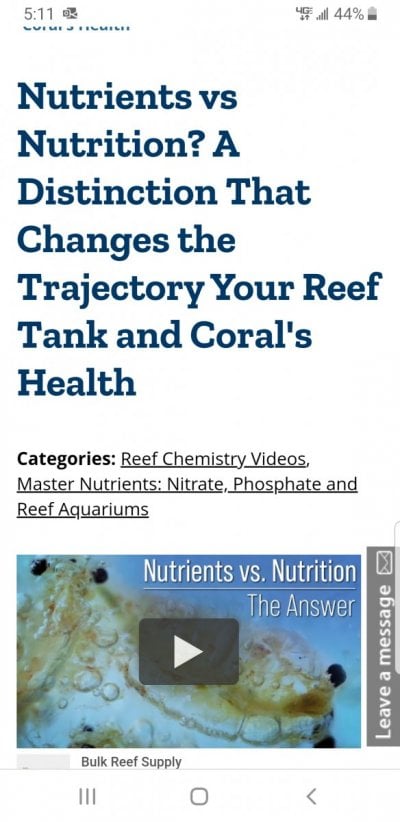I don't see anything wrong with .08 - .10 po4 and 2-4ppm No3 I have seen very nice full sps tanks running higher end with beautiful colors. I run full Zeovit so I'm on the near zero spectrum but I have to dose to keep colors nice. If I don't my sps pale out. I have switched to Phols concentrate and that has darkened and helped color up. But my sps grow well and have nice colors. If I could get .08 and 2ppm I'd be a happy camper.
Navigation
Install the app
How to install the app on iOS
Follow along with the video below to see how to install our site as a web app on your home screen.
Note: This feature may not be available in some browsers.
More options
You are using an out of date browser. It may not display this or other websites correctly.
You should upgrade or use an alternative browser.
You should upgrade or use an alternative browser.
Which is worse: high nitrates or high phosphates?
- Thread starter IsaiahS609
- Start date
- Tagged users None
- Joined
- Mar 31, 2018
- Messages
- 215
- Reaction score
- 136
my no3 a low like 0 ppm I feed a lot more to get them up I don't charge the water but ones a month so I don't drop to low I going to have to start and no3 I think just do know what one to buy thanks the feed backI don't see anything wrong with .08 - .10 po4 and 2-4ppm No3 I have seen very nice full sps tanks running higher end with beautiful colors. I run full Zeovit so I'm on the near zero spectrum but I have to dose to keep colors nice. If I don't my sps pale out. I have switched to Phols concentrate and that has darkened and helped color up. But my sps grow well and have nice colors. If I could get .08 and 2ppm I'd be a happy camper.
Do you know the name of the new series?16 to 1 is n to p. 10 to 1 is NO3 to PO4. BRS has a great new series that really dives into this and explains it thoroughly.
A good read for all the " High NO3/Low PO4" camp. NO3 appears to be more of an algae culprit too within reason.
(22) I'm dying on this hill - Phosphate is more important than alkalinity | REEF2REEF Saltwater and Reef Aquarium Forum
(22) I'm dying on this hill - Phosphate is more important than alkalinity | REEF2REEF Saltwater and Reef Aquarium Forum
Hans - the chemist for tropic Marin and inventor of the balling method now recommends 0.1 for phosphate based of studies and his own work and observations. He and Randy are pretty much *the* chemists for reefs so it’s worth consideration.

 www.reef2reef.com
www.reef2reef.com

Clean vs Dirty Water SPS
I don't think you guys really disagree about much. You all (probably) agree that throughput is important. I think whether you can pull off lower nutrients (e.g. NSW-level nitrate and phosphate) nowadays is tank and aquarist-specific and also depends on whether you have dry rock or live rock and...
 www.reef2reef.com
www.reef2reef.com
I have seen very little correlation in my tanks between measured levels of nitrates/phosphates and coral health. Phosphate has been mostly stable at around 0.2 for a while now and I have no algae problems. Nitrates did spike up to 50 ish a while back, thought here was no observable impact on coral health. Added a sulfur denitrator which has swapped elevated nitrates with sulfur. Hasn't made much difference other than the denitrator is a pain to dial in.
Life, er, uhhhh, finds a way....
Above everything I think balance/stability is the most important. These animals can survive just about anything in a stable environment. They die in situations where the tank owner obsesses over something. Every time you force parameters in a certain direction, you're fighting the tanks natural balance. This includes lighting. Small forced changes over long periods of time while letting nature play out is key.
Attachments
Do you know the name of the new series?
Attachments
Growing algae need phosphorus and nitrogen in their natural ratio.So high nitrates aren’t the main culprit of algae issues? It’s phosphate?
If you have a reserve of 0.1 ppm phosphate and 10ppm nitrate, if the algae use the nutrient reserve for growth, when all phosphate is used up, 9 ppm nitrate is left over. This means the phosphate reserve may become the growth limiting factor. Wich, I do not prefer. I would bring down the nitrate reserve to < 1ppm.
What is measured is what is NOT used or is NOT useable at the moment of measuring.
Nitrate, phosphate, and CO2 are endproducts of aerobic remineralization, breaking down organic waste to its essential components.
These components, the basic elements, may be reused for algae growth. All of them play an essential role, not only phosphate and nitrate. It is about reusing all building materials to close the carbon cycle in which algae play a very important role.
Algae are not the enemy and can be used for managing the nutrient content and nutrient balance in the system as their growth and growth rate easily can be managed using AAM! ref: MB CMF De Haes 2017-2021
Nitrate is safely stored nitrogen.
Increasing inorganic nutrients levels are the messengers of something going wrong and are the result of an existing problem, very exceptional the cause.
Why inorganic nutrients slowly can build up in a well-lit aquarium and are not used up?
When nitrate is used as a nitrogen source instead of ammonium, growth rates are reduced drastically.
it is a myth thinking nitrate does increase algae growth. Nitrate-nitrogen is constantly exported due to natural denitrification, ammonia-nitrogen stays in the system. If algae become a problem having a high nitrate level, imagine what would be the situation when the nitrogen present in the nitrate reserve would have been stayed available as ammonium-nitrogen.
It has been shown high nitrogen availability may be responsible for coral bleaching during periods of increased growth (increased temp?) due to phosphorus starvation, the phosphorus supply not being able to follow the fast increasing demand. Using nitrate-nitrogen slows down growth rates and it is very unlikely nitrate may be responsible for phosphorus starvation.
So, what would be the emergency included in the presence of nitrate?
Phosphate and phosphorus?
It has been shown a high availability of phosphate increases the calcification rates of corals. ref: MB CMF de Haes 2017-2019
These components, the basic elements, may be reused for algae growth. All of them play an essential role, not only phosphate and nitrate. It is about reusing all building materials to close the carbon cycle in which algae play a very important role.
Algae are not the enemy and can be used for managing the nutrient content and nutrient balance in the system as their growth and growth rate easily can be managed using AAM! ref: MB CMF De Haes 2017-2021
Nitrate is safely stored nitrogen.
Increasing inorganic nutrients levels are the messengers of something going wrong and are the result of an existing problem, very exceptional the cause.
Why inorganic nutrients slowly can build up in a well-lit aquarium and are not used up?
When nitrate is used as a nitrogen source instead of ammonium, growth rates are reduced drastically.
it is a myth thinking nitrate does increase algae growth. Nitrate-nitrogen is constantly exported due to natural denitrification, ammonia-nitrogen stays in the system. If algae become a problem having a high nitrate level, imagine what would be the situation when the nitrogen present in the nitrate reserve would have been stayed available as ammonium-nitrogen.
It has been shown high nitrogen availability may be responsible for coral bleaching during periods of increased growth (increased temp?) due to phosphorus starvation, the phosphorus supply not being able to follow the fast increasing demand. Using nitrate-nitrogen slows down growth rates and it is very unlikely nitrate may be responsible for phosphorus starvation.
So, what would be the emergency included in the presence of nitrate?
Phosphate and phosphorus?
It has been shown a high availability of phosphate increases the calcification rates of corals. ref: MB CMF de Haes 2017-2019
You may have had Dino’s and thought it was hair algae!Please explain how you know this, and how do you define high phosphate? I got hair algae at 0 phosphate. Now it's at .1, and the GHA is going away.
Something to take in mind. Symbodynium in corals are Dino's. it has been shown coral bleaching may be caused by phosphorus starvation during periods of high growth rates. ( high ammonia- nitrogen availability and increasing temp)You may have had Dino’s and thought it was hair algae!
Old wives taleYea 16 to 1 usually
Randy Holmes-Farley
Reef Chemist
View Badges
Staff member
Super Moderator
Excellence Award
Expert Contributor
Article Contributor
R2R Research
My Tank Thread
- Joined
- Sep 5, 2014
- Messages
- 67,160
- Reaction score
- 63,512
You may have had Dino’s and thought it was hair algae!
FWIW, this thread is three years old that the person you are replying to has not been on in several months.
Similar threads
- Replies
- 5
- Views
- 147
- Replies
- 3
- Views
- 160
- Replies
- 12
- Views
- 310
- Replies
- 11
- Views
- 312

















